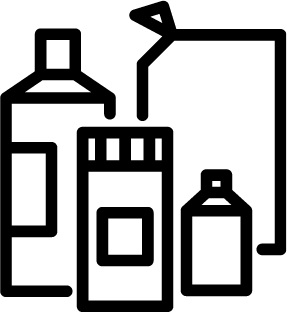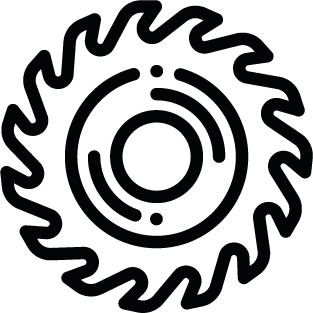FAQs — Sealing
Does natural stone need to be sealed?
We strongly recommend sealing natural stone if it has a sawn or smooth surface. Our recommended sealant is Dry Treat Stain Proof. It can also be beneficial to seal riven natural stone. This will make cleaning and maintenance much easier and will help to prevent permanent staining to the stone. This is even more important in high traffic areas. For example, a driveway is likely to suffer the occasional oil droplet or tyre marks. Overhanging trees can drop sap, BBQs will mean spillages of drinks, fat and food, pets may tread muddy paw prints across the patio. In all these instances, it’s strongly advised that you seal your stone to help protect against permanent stains.
Please note; a sealant will not negate the need for a cleaning and maintenance program. Whilst Dry Treat will help to protect against permanent stains which are absorbed into the stone, it will not stop marks, footprints, spillages etc. from appearing on the surface of the stone. The aim of the sealant is to make these marks easier to clean off so that, with the right cleaning regime, your stone can be brought back to its best.
How long after installing the stone can I apply a sealant?
Ideally, the sealant should be applied prior to installation. This allows you to help protect the stone during the installation process and will also help to prevent efflorescence. If you’ve already installed the stone, you can still seal it retrospectively. In this case, you must ensure that the stone is clean and completely dry all the way through – please be aware that stone can appear to be dry on the surface whilst still retaining moisture underneath. For this reason, sealing is best done after a period of warm, dry weather which will mean waiting until spring or summer. Do not seal stone which is showing signs of efflorescence (a cloudy, whitish bloom on the surface, caused by salt particles being drawn up through the stone from the bedding layer). We recommend waiting at least 6 weeks after installation before applying a sealant to be sure that efflorescence is not going to occur.
What happens if you seal stone before/during efflorescence?
This will make the efflorescence much more difficult, or impossible, to remove. We strongly recommend sealing the stone prior to installation to help protect against efflorescence – we can pre-seal the stone before delivery for you. Efflorescence, characterised by white, cloudy marks, is caused by salts from the bedding layer leeching through to the surface of the stone. It is a temporary phenomenon, affecting only a small percentage of projects, which will disappear on its own over time. Unfortunately this can take a couple of weeks, several months or even longer. You can speed up the process by regularly cleaning the stone but ultimately the efflorescence must run its course.
What happens if I seal stone which is dirty or wet?
Dirty marks will be much harder to clean if you have applied sealant over the top of them. The sealant will have coated the particles of dirt, potentially missing patches of the stone itself and meaning that you may also need to reapply more sealant after you’ve cleaned the marks off. Sealing when the stone is wet means that the sealant will effectively become diluted and will not perform as effectively as it should. Again, this will require re-sealing which adds additional cost.
Is it possible to over apply the product?
The stone will reach a natural saturation point, meaning that no further sealant can be absorbed. Any excess sealant needs to be wiped away from the surface. Leaving excess sealant on the surface will cause sticky, shiny patches so it’s important to ensure that they are wiped away as per the sealing guide.
What happens if I put more sealant on one area than another?
It’s best to apply your sealant with a spray applicator to ensure an even coverage. If you follow the directions closely, apply the recommended number of coats and make sure to wipe away any excess then you should find that coverage is even across the paved area. Any areas which have not received a full application of Dry Treat, as per the directions on the packaging, will not be fully protected and will require further application.
What happens if the paving gets wet before the sealant has had chance to dry?
This is another benefit to having your stone pre-sealed by us before delivery – we seal the stone indoors and it arrives with you ready to install. If you’re planning to seal the stone after installation, check the weather forecast and wait for a period of warm, dry weather. If it does rain after you apply the sealant, the effect on your stone will depend on how quickly the stone got wet after sealing and how much it rained. A very light shower 4 hours after the sealant is applied may mean that you need to apply an extra coat of sealant once the stone is dry again. A torrential downpour or someone jet-washing the stone may require sealing again from scratch once the stone is dry.
Should I seal the bottom of the slabs for extra protection?
Please make sure that you seal the surface only – sealing the underside of the slabs could affect adhesion between the slab and the bedding layer. It also won’t offer any additional protection for the stone and will cost you twice as much money.
I didn’t wipe away all the excess sealant and now there are shiny patches of dried sealant on the surface of the stone. How can I get rid of them?
In the first couple of days or so after sealing, you should be able to remove any excess using a clean, white cloth dampened with the original sealing product. In hot weather this time window will be narrower. Acetone can be used in the same way for about the next 7 days. After this time period, the sealant will have cured and will be exceptionally difficult to remove.
How soon after sealing can I jet-wash the stone?
We recommend waiting at least 30 days before you jet-wash your paving to avoid any issues.













